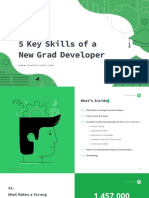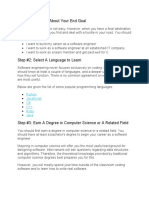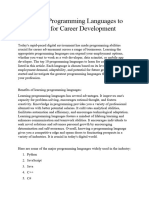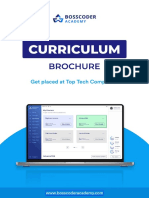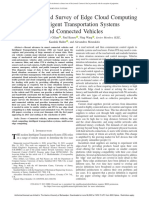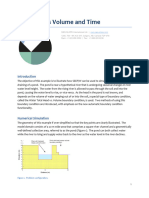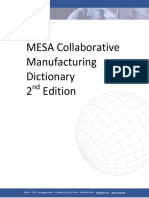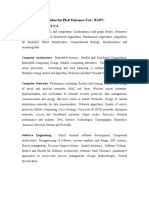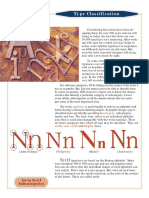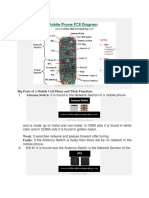0 ratings0% found this document useful (0 votes)
15 views11 pagesComprehensive Tech Career Roadmap
Ghhbhfcbmii
Uploaded by
vinayakreddy2027Copyright
© © All Rights Reserved
We take content rights seriously. If you suspect this is your content, claim it here.
Available Formats
Download as PDF, TXT or read online on Scribd
0 ratings0% found this document useful (0 votes)
15 views11 pagesComprehensive Tech Career Roadmap
Ghhbhfcbmii
Uploaded by
vinayakreddy2027Copyright
© © All Rights Reserved
We take content rights seriously. If you suspect this is your content, claim it here.
Available Formats
Download as PDF, TXT or read online on Scribd
You are on page 1/ 11
A Definitive Roadmap to a Top-Tier
Software Engineering Career
Executive Summary
Securing a software engineering position at a top product-based company, a multinational
corporation (MNC), or an international tech firm requires more than just technical proficiency.
This pursuit is a strategic, multi-faceted journey that can be organized into three core pillars:
building a solid technical foundation, cultivating a professional brand, and mastering the
interview process. This report provides a comprehensive blueprint, offering an exhaustive,
step-by-step guide from a complete novice to a successfully placed professional. The analysis
reveals that the most significant opportunities lie in a strategic alignment with future-facing
technologies such as artificial intelligence and cloud computing. Success hinges on
demonstrating not only mastery of fundamental computer science principles but also on
showcasing crucial non-technical skills like communication and problem-solving, which are
increasingly vital in the evolving landscape of remote and global teams. The findings indicate
that a candidate's ability to market their skills through a quantifiable resume and an interactive
project portfolio is as critical as their coding ability. Ultimately, the path to a top-tier role is not a
race but a process of continuous learning and strategic execution, guided by a deep
understanding of what top companies truly value.
Part I: The Foundational Pillar - Building a Solid
Technical Core
The bedrock of a successful software engineering career is a robust set of foundational
technical skills. Top-tier companies prioritize candidates who demonstrate a deep understanding
of these principles, as they are the building blocks for creating resilient and efficient software.
This section details the non-negotiable skills required to become a competitive candidate.
Chapter 1: The First Steps: Mastering Your First Programming
Language
The journey begins by selecting and mastering a programming language. This choice is less a
permanent career decision and more a vehicle for learning fundamental programming concepts
that are universally applicable. While many languages are viable, a strategic approach involves
selecting one that is both beginner-friendly and aligned with current industry demand.
A comparative analysis of popular beginner languages reveals several strategic options. Python
stands out as an ideal starting point due to its simplicity and readability. Its versatility makes it a
dominant force in data science, artificial intelligence (AI), and backend development. The rise of
data-centric roles has directly contributed to Python's immense popularity, making it a powerful
choice that aligns a candidate with the fastest-growing sectors of the tech industry.
For those interested in web development, JavaScript is an essential language to master. With
the rise of Node.js, JavaScript has evolved into a versatile tool for both frontend and backend
development, making it the gateway to full-stack roles. Java and C++ are also robust options.
Java remains a top choice for enterprise-level applications and Android development due to its
portability and robustness, while C++ is the heavyweight of performance-critical applications like
game development. The choice of a first language should therefore be seen as a strategic
decision based on a person’s long-term career interests. The ultimate goal is not to become a
programmer in a specific language but to learn how to think like a programmer.
Regardless of the language chosen, the focus must be on mastering core concepts. This
includes a thorough understanding of variables and data types, control structures like if
statements and loops, and the principles of Object-Oriented Programming (OOP). For instance,
mastering Java requires a firm grasp of variables, loops, conditional statements, and classes
and objects. A fundamental understanding of these concepts forms the foundation for all future
learning.
The acquisition of these skills is not a passive process; it is a skill that improves only with
consistent practice. A novice should begin with small, simple projects that reinforce the
fundamentals. Examples include building a basic calculator, a to-do list manager, or a weather
application that uses an API. These small projects are crucial for internalizing concepts and
building confidence before tackling more complex challenges.
Chapter 2: The Architect's Toolkit: Data Structures & Algorithms
(DSA)
A strong command of Data Structures and Algorithms (DSA) is the cornerstone of technical
interviews for top-tier tech companies. Mastering DSA enables a developer to write optimized
code that performs well even with large datasets, a critical skill for building efficient software.
The interview is designed to test a candidate's ability to solve complex problems by applying
these fundamental concepts.
A structured, multi-level roadmap is the most effective way to master DSA. The journey begins
with linear data structures, which are valued for their simplicity. This includes arrays, linked lists,
stacks, and queues. Once these are understood, the focus shifts to basic algorithms like binary
search, greedy algorithms, and sorting. The next level involves non-linear data structures such
as trees, graphs, and hash tables, which are necessary for performing complex operations on a
variety of data. The roadmap culminates with advanced concepts like dynamic programming,
recursion, and bit manipulation.
A crucial component of this mastery is the ability to analyze an algorithm’s efficiency. This is
measured using asymptotic notations such as Big O Notation (O()), Omega Notation
(\Omega()), and Theta Notation (\Theta()). Understanding these notations allows a developer to
measure an algorithm’s time and space complexity as the input size grows, a topic frequently
covered in technical interviews.
To achieve mastery, consistent and deliberate practice is essential. There is a distinction to be
made between memorizing solutions and developing a systematic problem-solving mindset.
Platforms like LeetCode and HackerRank offer a vast library of problems that help build
problem-solving "muscle memory". LeetCode, in particular, is considered the "gold standard" for
interview preparation due to its extensive problem sets and company-specific questions. Other
platforms like AlgoExpert offer a more structured, video-based learning path that focuses on
teaching the underlying patterns that connect different coding problems. This approach is
designed to teach a person how to think like a programmer, not just recognize patterns from
previously solved problems. The emphasis should always be on understanding the rationale
behind the solution rather than merely replicating it.
Chapter 3: The System Builder's Mindset: System Design Principles
While DSA is crucial for entry-level roles, system design is a critical skill for mid-to-senior level
positions, as it assesses a person's ability to design large-scale, distributed systems. A
successful candidate demonstrates an understanding of the entire system architecture, from
high-level concepts to the interactions between different components.
The foundational concepts of system design are imperative to master. These include scalability
(the ability to handle a growing workload), reliability (the probability of operating without failure),
and availability (the percentage of time the system is operational). A candidate must also
understand performance metrics like latency and throughput, and how to build systems with
fault tolerance to continue operating despite component failures.
A core aspect of a system design interview is a person’s capacity to articulate the trade-offs
involved in architectural decisions. There is rarely a perfect solution; optimizing one aspect often
comes at the expense of another. A person should be able to discuss and justify choices
between, for instance, SQL and NoSQL databases, or monolithic versus microservices
architecture. This type of question is a test of a candidate’s critical thinking and communication
skills, demonstrating an ability to make high-level decisions and justify them to a team.
The system design interview also assesses familiarity with essential design elements. This
includes a person’s knowledge of load balancers, Content Delivery Networks (CDNs), and
distributed caches. An understanding of microservices architecture, including the roles of API
gateways and service discovery, is also vital. By demonstrating a systematic approach to
problem-solving and a deep understanding of these core principles, a person can prove their
ability to build efficient and robust systems.
Part II: The Specialization Spoke - Finding Your Niche
Beyond foundational skills, the modern tech landscape demands specialization. The most
successful careers are built by transitioning from a generalist to a professional with expertise in
a high-demand niche.
Chapter 4: The In-Demand Skills of Tomorrow
The tech job market is being reshaped by the rapid advancement of emerging technologies,
leading to a soaring demand for professionals with specialized skills. Companies are shifting
their hiring strategies away from strict degree requirements and are instead focusing on
skills-based recruitment. This trend is creating a decentralized job market where opportunities
are no longer confined to traditional tech hubs. For example, the consumer goods sector saw a
158% increase in software engineering roles, outpacing traditional tech and logistics. This
reflects a broader digital transformation across all industries, where legacy brands are investing
heavily in e-commerce, AI, and supply chain technology, and in turn, are competing for top tech
talent.
The fastest-growing, in-demand niches for 2025 include:
● Machine Learning (ML) & AI Engineering: These engineers are at the forefront of
innovation, with the global AI market projected to grow at a Compound Annual Growth
Rate (CAGR) of 37.3%. A comprehensive roadmap to this field starts with a solid
foundation in mathematics and statistics, including linear algebra and calculus. From
there, a person can progress to core ML concepts such as data collection and cleaning,
exploratory data analysis, and feature engineering. The journey culminates in a deep
understanding of supervised and unsupervised learning, as well as advanced topics like
computer vision and reinforcement learning.
● Cloud Computing & DevOps: The shift to cloud-based infrastructure has made cloud
architects and DevOps engineers indispensable. A person’s path to this niche begins with
foundational IT skills such as networking, operating systems, and database management.
The next step is to gain expertise in a specific cloud platform like Amazon Web Services
(AWS), Google Cloud Platform (GCP), or Microsoft Azure, and earn relevant certifications
such as the AWS Certified Solutions Architect or Microsoft Azure Solutions Architect.
Understanding concepts like containerization with Docker and orchestration with
Kubernetes is also crucial for success in this domain.
● Cybersecurity: With the growing threat of cyberattacks, the demand for cybersecurity
professionals is skyrocketing. A person can choose from various career paths, including
cybersecurity analyst (a frontline defender), ethical hacker (a person who mimics attacks
to find vulnerabilities), or security architect (a person who designs and builds secure
systems). The journey requires foundational knowledge of network security, incident
response, and threat intelligence, with certifications like CompTIA Security+ or CISSP
being highly beneficial.
Chapter 5: Cultivating the Intangibles: The Power of Soft Skills
In the modern tech industry, technical proficiency alone is insufficient. Non-technical or "soft"
skills are now considered hard skills, as they directly impact a person's ability to succeed in a
collaborative, fast-paced environment. The increasing prevalence of remote and global teams
has made these skills more valuable than ever. Communication, in particular, is an essential
characteristic that every hiring manager considers.
The following are eight essential soft skills that every software engineer should cultivate:
● Communication: A person must be able to communicate clearly and fluently with
teammates, project managers, and even clients. In the absence of face-to-face
interaction, clear, confident, and empathetic communication is a critical tool for success.
● Problem-Solving & Critical Thinking: This is the heart of software development. A
person should be curious and possess the capacity to identify and solve problems,
anticipating user needs and ensuring applications are free from common issues.
● Empathy: A developer must have the capacity to understand the experiences of others,
whether it's a teammate or an end-user. Empathy helps a person design valuable
products by addressing the common problems end-users face.
● Collaboration & Teamwork: Modern software development is a "team sport". A person
must be able to work closely with various teams and rely on other soft skills like
communication and time management to function as a "well-oiled machine".
● Adaptability & Continuous Learning: The tech industry is in a state of constant
evolution. A person must have a growth mindset and a commitment to continuous
learning to stay current with new technologies and roles.
● Time Management & Accountability: These are critical for managing deadlines and
juggling multiple tasks simultaneously. A person must be able to manage their time
effectively and take ownership of their mistakes, addressing them and moving on.
● Leadership Skills: These are important for leading team projects and distributing work
appropriately.
● Creativity: Businesses scale on creativity. An open-minded person who is willing to take
chances with their code and discover new solutions is a valuable asset to any team.
Part III: The Professional Arsenal - Building Your
Brand
Once a person has built a strong technical core and cultivated essential soft skills, the next step
is to market themselves to potential employers. This requires crafting a compelling professional
brand through a high-impact resume and a demonstrable project portfolio.
Chapter 6: Crafting Your Story: The High-Impact Resume & Portfolio
A resume is no longer just a list of past jobs; it is a technical document that must be optimized
for both machines and humans. Applicant Tracking Systems (ATS) are used by companies to
screen thousands of resumes before they are seen by human eyes, making ATS-friendliness a
non-negotiable requirement. A poorly formatted or un-optimized resume will likely be rejected
automatically by the ATS, regardless of a person’s qualifications.
To create an ATS-friendly resume, a person should use a clean, functional template with
standard fonts like Arial or Calibri, and avoid using graphics, headers, or footers. The document
must be saved as a PDF and follow a standard order of sections: a professional summary,
contact information, skills, work experience, education, and projects. Keywords from the job
description must be incorporated throughout the resume to improve its ranking in the ATS.
The most impactful resumes go beyond listing duties and instead prove value with quantifiable
outcomes. The best way to do this is to use a formula: [Action Verb] + + [Quantifiable Outcome].
This approach demonstrates a person’s real impact and ownership of a project. For example,
instead of writing "Worked on a front-end," a person should write, "Refactored React
components, improving load speed by 50%". Other powerful examples include, "Reduced the
time by 75% to process 70,000 to 1,00,000 instruments" or "Spearheaded the revamp of tech
stack which resulted in 40% decrease in server costs".
The project portfolio is a junior developer's "golden ticket" for standing out to hiring managers.
Recruiters want to see a person’s ability to independently identify and solve a problem, not just
follow instructions from assigned coursework. A person should focus on creating "off-trail"
projects based on hobbies or real-world problems they face. Examples include a full-stack web
application, a mobile app redesign, or a contribution to an open-source project on GitHub. A
high-quality GitHub repository should have an "instantly interactive" README file with direct
links to the live application or embedded videos/GIFs that showcase the work.
Chapter 7: The Strategic Job Search & Networking
A successful job search is a strategic, social game that requires persistence and emotional
intelligence. While job boards like Indeed and LinkedIn are useful, the most effective strategy is
leveraging referrals. Recruiters prioritize referred applications because they are already vetted
and tend to be hired 55% faster.
A person can get a referral from a direct contact, a mutual friend, or a complete stranger
through cold outreach. When asking a friend, a person should be direct, share a link to the
specific role, and provide their resume. If the contact is more of an acquaintance, a person
should first ask to catch up to learn about their experience at the company before asking for a
referral.
Cold outreach is the most challenging path but can be highly effective if done correctly. The
most common mistake is to send a generic, impersonal message that appears to be asking for a
handout. This approach is often a waste of time, as a referral is a person putting their
professional reputation on the line. A successful cold message must be personalized and
demonstrate genuine interest in the person's work. For example, a person can start by
mentioning a post they found helpful or an article they read on the company's engineering blog.
The message should be concise and combine politeness with the specific ask, making it easy
for the person to help.
Part IV: The Final Gauntlet - Acing the Interviews
The interview process at top-tier companies is a holistic assessment designed to simulate
real-world work. It includes technical assessments to test coding skills and behavioral interviews
to assess a person's fit for the team and company culture.
Chapter 8: The Technical Interview: Proving Your Code
The technical interview process typically begins with a timed online assessment or coding
challenge, similar to problems found on platforms like LeetCode or HackerRank. These
assessments test a person's algorithmic thinking and their ability to write clean, readable code
under pressure. It is important to practice common data structures and algorithms under timed
conditions to build muscle memory.
The next stage is often a live coding or whiteboard challenge. The purpose of this round is not
just to find the correct answer but to understand a person's thought process. A person should
verbalize their reasoning out loud, ask clarifying questions before writing any code, and discuss
the trade-offs of their solution.
For more senior roles, a person will also face a machine coding round (LLD) or a system design
round (HLD). The machine coding round tests a person’s knowledge of OOP and design
principles, requiring them to build a small-scale, working application that follows good design
practices. The system design round assesses a person’s ability to design large-scale,
distributed systems, and their capacity to make high-level architectural decisions.
Chapter 9: The Behavioral Interview: Proving Your Fit
The behavioral interview is a crucial round where a person’s soft skills and cultural fit are
assessed. The logic is simple: a person’s past actions are a strong indicator of their future
behavior. Companies like Amazon and Google use this round to evaluate a person on core
principles such as leadership, conflict resolution, and adaptability.
The gold standard for preparing for this round is the STAR method:
● Situation: A person must briefly set the scene and provide context for their story.
● Task: They should then describe their specific role or the challenge they faced.
● Action: This is the most crucial part. A person must explain the specific steps they took,
focusing on their individual contributions using "I" instead of "we".
● Result: Finally, they should detail the outcome of their actions and, whenever possible,
quantify the results with metrics.
A person should prepare stories for common behavioral questions, such as "Tell me about a
time you worked on a team project" or "Describe a complex problem you faced at work and how
you solved it". The interview is a test of a person's passion for tech, their ability to work on a
team, and their approach to failure, as these factors are highly predictive of their long-term
success at a company.
Part V: The Global Career - Opportunities Abroad
The international tech job market is an attractive option for many, but it requires a careful,
strategic decision based on personal priorities and career goals. There is no single "best"
country; the optimal choice depends on a person’s trade-offs between salary, innovation, visa
complexity, and work-life balance.
Chapter 10: International Job Market & Visa Sponsorship
A comparative analysis of the top tech markets reveals distinct trade-offs:
● United States: The US remains the undisputed global tech leader with the highest
average salaries and a concentration of Big Tech companies. The downside is the highly
complex, lottery-based H-1B visa process.
● Canada: Canada is a global magnet for tech talent, offering a fast-track immigration
process via the Global Talent Stream and Express Entry. The country is known for its
stability and work-life balance but offers lower average salaries compared to the US.
● United Kingdom: The UK tech scene is a hub for fintech and AI, with direct visa
pathways like the Global Talent Visa and the Skilled Worker Visa. The UK offers a good
work-life balance with ample paid leave and universal healthcare.
● Australia: Australia is a growing market with a skills-based migration system that allows a
pathway to permanent residency. This country is a great option for those seeking a
balance of career growth and a high quality of life.
The broader trend in global hiring is a shift towards skills-based recruitment, remote-friendly
structures, and global talent sourcing. Companies are increasingly valuing practical experience
and certifications over traditional degrees.
Chapter 11: Navigating Visa Processes for Software Engineers
The visa application is a critical, multi-step process that can be complex and time-consuming.
Below is a detailed overview of the major work visas for software engineers.
● USA (H-1B Visa): This is the most common visa for foreign workers in specialty
occupations. The process begins with an employer filing a petition on behalf of the
employee. Due to high demand, a lottery system is used to randomly select which
petitions will be processed. A person must have at least a bachelor's degree or its
equivalent in a related field, and the employer must be willing to sponsor them.
● Canada (Express Entry): This is an online system used to manage immigration
applications from skilled workers. A person creates a profile and is ranked based on a
Comprehensive Ranking System (CRS) that considers age, education, work experience,
and language proficiency. Having a valid job offer and a Labour Market Impact
Assessment (LMIA) can significantly boost a person’s score.
● UK (Skilled Worker & Global Talent Visas): The Skilled Worker visa requires a person
to have a job offer from an approved UK employer and meet a minimum salary and
English language requirement. The Global Talent visa is for leaders or potential leaders
in digital technology and does not require a job offer, allowing for more flexibility.
● Australia (TSS & General Skilled Migration): The Temporary Skill Shortage (TSS)
visa requires an Australian employer to sponsor a person. A person may also be eligible
for the Skilled Independent visa (Subclass 189), which is a points-tested, permanent
residency visa. Both require a person to have their skills assessed by a relevant authority,
such as the Australian Computer Society (ACS).
Conclusion: Your Journey Begins
The journey to a top-tier software engineering career is a marathon, not a sprint. This report has
laid out a definitive roadmap, from mastering the first lines of code to strategically navigating the
global job market. The core message is that success is a function of disciplined, continuous
effort and a multi-faceted approach. A person must become a lifelong learner, adapting to an
ever-evolving technological landscape by mastering new languages and skills. Success hinges
not on just what a person knows, but on their ability to demonstrate that knowledge through a
quantifiable professional brand. This means crafting a resume that passes automated systems,
building a portfolio that proves their problem-solving ability, and networking with a purpose.
The most successful candidates are those who view the interview process not as a series of
hurdles to overcome, but as a series of conversations to demonstrate their value. By preparing
for technical and behavioral questions with equal rigor, a person can prove that they are not only
capable of doing the work, but are also an empathetic, adaptable, and collaborative team
member. The strategic choice of a first language, a specialized niche, or an international market
is a personal decision that must be aligned with long-term career goals. The most powerful tool
a person possesses is not a specific skill or a prestigious degree, but a strategic mindset and
the resilience to learn, build, and adapt. The journey to a dream job starts here.
Works cited
1. The Ultimate Roadmap to Becoming a Software Engineer: From ...,
https://algocademy.com/blog/the-ultimate-roadmap-to-becoming-a-software-engineer-from-novic
e-to-faang-ready/ 2. Best Programming Languages to Learn in 2025 | Complete List -
Simplilearn.com,
https://www.simplilearn.com/best-programming-languages-start-learning-today-article 3. Top 10
Future Programming Languages for 2025 - Crossover,
https://www.crossover.com/resources/future-programming-languages-for-2025 4. 2025 Software
Job Trends: Top Skills, States & Employers - Aura Intelligence,
https://blog.getaura.ai/2025-software-job-trends 5. IT Job Trends: Top 7 Tech Jobs Trends to
Watch in 2025 - ISHIR,
https://www.ishir.com/blog/135404/it-job-trends-top-7-tech-jobs-trends-to-watch-in-2025.htm 6.
Complete Roadmap To Learn DSA - GeeksforGeeks,
https://www.geeksforgeeks.org/dsa/complete-roadmap-to-learn-dsa-from-scratch/ 7. Software
Engineer Roadmap: How to Become Successful | Coding Temple,
https://www.codingtemple.com/blog/software-engineer-roadmap/ 8. Learn Data Structures and
Algorithms - Roadmap - CodeChef,
https://www.codechef.com/roadmap/data-structures-and-algorithms 9. Technical Assessment
Preparation: The Complete Developer Guide ...,
https://hackajob.com/talent/technical-assessment 10. 10 Best LeetCode Alternatives for Coding
Practice and Interview Prep (2025) - AlgoCademy,
https://algocademy.com/blog/top-leetcode-alternatives-for-coding-practice/ 11. AlgoExpert vs.
Leetcode - Which program is better? - Coding Interview Course,
https://codinginterviewcourses.com/algoexpert-vs-leetcode/ 12. Algoexpert Vs Hackerrank Vs
Leetcode - [Cracking The Coding Interview] - The Yuvas,
https://theyuvas.com/algoexpert-vs-hackerrank-vs-leetcode/ 13. SDE 2 Interview Preparation
Roadmap for Product-Based Companies - workat.tech,
https://workat.tech/general/article/sde-2-interview-prep-ultimate-guide-dn1am88dbutl 14. The
Software Design /System Design Interview Preparation ...,
https://dev.to/somadevtoo/the-software-design-system-design-interview-preparation-roadmap-wi
th-resources-1no0 15. Roadmap to Prepare for a System Design Interview: A Beginner's ...,
https://medium.com/@roopa.kushtagi/roadmap-to-prepare-for-a-system-design-interview-a-begi
nners-guide-5399176f7a20 16. 9 Tech Hiring Trends to Be Aware of in 2025 - 4 Corner
Resources, https://www.4cornerresources.com/blog/ways-tech-hiring-will-change/ 17. 2025 Tech
job market and salary trends - Michael Page,
https://www.michaelpage.com/advice/management-advice/2025-tech-job-market-and-salary-tren
ds 18. Machine Learning Roadmap - GeeksforGeeks,
https://www.geeksforgeeks.org/blogs/machine-learning-roadmap/ 19.
farukalamai/advanced-machine-learning-engineer-roadmap-2024 - GitHub,
https://github.com/farukalamai/advanced-machine-learning-engineer-roadmap-2024 20. How to
Become a Cloud Architect: Degrees, Skills, Jobs, Courses | Coursera,
https://www.coursera.org/articles/how-to-become-a-cloud-architect 21. How to Become a Cloud
Architect: Start Your Journey Here [2025] - Simplilearn.com,
https://www.simplilearn.com/how-to-become-cloud-architect-article 22. Cybersecurity Career
Paths: Navigating the Options - ISC2,
https://www.isc2.org/Insights/2024/02/cybersecurity-career-paths-navigating-the-options 23.
Cybersecurity Career Paths: Entry and Mid-Level Guide - ACI Learning,
https://www.acilearning.com/blog/cybersecurity-career-guide-entry-level-to-mid-level-advancem
ent-overview/ 24. 10 Soft Skills Every Software Engineer Should Have - Trio Dev,
https://trio.dev/software-engineer-soft-skills/ 25. 6 Non-Technical Skills A Software Developer -
Code Institute Global,
https://codeinstitute.net/global/blog/6-essential-non-technical-skills-a-software-developer-should
-have-in-2022/ 26. 10 Most In-Demand Skills in 2025 That You Will Need - City University of
Seattle, https://www.cityu.edu/blog/skills-in-demand-2025/ 27. Practical guide to writing
FAANG-ready software engineer resumes ..., https://www.techinterviewhandbook.org/resume/
28. Software Engineer Resume: The Ultimate Guide (2025) | Leland,
https://www.joinleland.com/library/a/how-to-craft-an-effective-software-engineering-resume 29.
How to get a job in the USA from India 2025: (5 easy steps) - Instarem,
https://www.instarem.com/blog/how-to-get-a-job-in-the-usa-from-india/ 30. 19 Software Engineer
Resume Examples & Guide for 2025 - Enhancv,
https://enhancv.com/resume-examples/software-engineer/ 31. Top tech projects to build your
portfolio in 2025 - General Assembly, https://generalassemb.ly/blog/tech-portfolio-projects-2025/
32. Hobbies to Hired: 5 tips for making great Portfolio Projects to Land ...,
https://medium.com/@zackakil/hobbies-to-hired-5-tips-for-making-great-portfolio-projects-to-lan
d-your-first-tech-job-8c45aaeafd06 33. A Comprehensive Guide to Getting a Referral for Your
Tech Job ..., https://www.tryexponent.com/blog/guide-to-tech-job-employee-referral 34. Top Job
Search Strategies for Tech Professionals - Coding Temple,
https://www.codingtemple.com/blog/job-search-strategies-for-tech-professionals/ 35. Actual
messages you can send to get referred into a tech company ...,
https://medium.com/the-ascent/actual-messages-you-can-send-to-get-referred-into-a-tech-comp
any-e80430218ae9 36. LinkedIn networking as a junior dev | by Kat Connolly | Medium,
https://connkat.medium.com/linkedin-networking-as-a-junior-dev-8b2424ce931a 37. Conducting
Interviews - Technical Recruiting and Hiring - Holloway,
https://www.holloway.com/g/technical-recruiting-hiring/sections/conducting-interviews 38.
Prepare for a Software or Technical Interview | Columbia Career ...,
https://www.careereducation.columbia.edu/resources/prepare-software-or-technical-interview
39. Software engineer interview process | Gearset Careers,
https://gearset.com/careers/culture/software-engineer-interview-process/ 40. FAANG Behavioral
Interview Guide - Design Gurus,
https://www.designgurus.io/blog/faang-behavioral-interview-guide 41. How to Ace The Technical
Interview [A Complete Guide], https://learntocodewith.me/posts/technical-interview/ 42. The
STAR method | National Careers Service,
https://nationalcareers.service.gov.uk/careers-advice/interview-advice/the-star-method 43.
Behavioral Interview Questions for FAANG Software Engineers,
https://interviewkickstart.com/blogs/interview-questions/behavioral-interview-questions-faang-sof
tware-engineer-interview 44. Canada, USA and UK: Best Country for Tech Jobs in 2025 -
Techotlist, https://techotlist.com/blogs/global-work-options/best-country-tech-jobs-2025 45.
Australian Visa Options For Software Engineers - PAX Migration,
https://paxmigration.com.au/resources/australian-visa-options-for-software-engineers/ 46. The
Tech Scene: Comparing the US and UK Tech Industries - Rewriting the Code,
https://rewritingthecode.org/uk-vs-us-tech-industries/ 47. H1B Visa for Software Engineers: Your
Complete Guide - Herman Legal Group,
https://www.lawfirm4immigrants.com/h1b-for-software-engineer/ 48. Process, Requirements and
H1B Visa for Indians - ACKO Insurance, https://www.acko.com/visa/h-1b-visa/ 49. Immigrate
through Express Entry - Canada.ca,
https://www.canada.ca/en/immigration-refugees-citizenship/services/immigrate-canada/express-
entry.html 50. technation.io,
https://technation.io/global-talent-visa/#:~:text=The%20Global%20Talent%20Visa%20allows,%2
C%20company%2C%20or%20job%20offer.&text=If%20you%20are%20well%2Destablished,yo
u%20should%20explore%20this%20pathway. 51. Requirements For Remote Tech Jobs In
Australia For Indians 2025 (2025 Guide),
https://www.primepathway.in/guides/requirements-for-remote-tech-jobs-in-australia-for-indians-2
025-2025-guide 52. The H-1B Visa, Explained - Boundless,
https://www.boundless.com/immigration-resources/the-h-1b-visa-explained/ 53. $52-$76/hr H1B
Software Jobs (NOW HIRING) Aug 2025 - ZipRecruiter,
https://www.ziprecruiter.com/Jobs/H1B-Software 54. Calculate Your Express Entry CRS Score -
Canadavisa.com, https://www.canadavisa.com/comprehensive-ranking-score-calculator.html 55.
Canada PR Points Calculator–Check CRS Score Online - Aptech Visa,
https://www.aptechvisa.com/canada-pr-points-calculator 56. Job offer - Express Entry -
Canada.ca,
https://www.canada.ca/en/immigration-refugees-citizenship/services/immigrate-canada/express-
entry/documents/job-offer.html 57. Skilled Worker Visa: Application & Eligibility Guide 2025 |
DavidsonMorris, https://www.davidsonmorris.com/skilled-worker-visa/ 58. Skilled Worker visa:
Overview - GOV.UK, https://www.gov.uk/skilled-worker-visa 59. Work in the UK as a leader in
digital technology (Global Talent visa) : Overview - GOV.UK,
https://www.gov.uk/global-talent-digital-technology 60. Software Engineer - ANZSCO 261313 -
VisaEnvoy, https://visaenvoy.com/sol/software-engineer/ 61. Pathway to Australian Permanent
Residency: Information Technology - IDP IELTS New Zealand,
https://ielts.co.nz/newzealand/prepare/article-pathway-to-australian-permanent-residency-inform
ation-technology
You might also like
- For Software Development What Is The Roadmap and INo ratings yetFor Software Development What Is The Roadmap and I3 pages
- Cracking The Coding Interview - 189 Programming Questions and Solutions (6th Edition) (EnglishOnlineClub - Com)100% (11)Cracking The Coding Interview - 189 Programming Questions and Solutions (6th Edition) (EnglishOnlineClub - Com)708 pages
- Gayle Laakmann McDowell - Cracking The Coding Interview - 189 Programming Questions and Solutions (2015, CareerCup)82% (49)Gayle Laakmann McDowell - Cracking The Coding Interview - 189 Programming Questions and Solutions (2015, CareerCup)708 pages
- The Self-Taught Programmer - The Definitive Guide To Programming Professionally100% (1)The Self-Taught Programmer - The Definitive Guide To Programming Professionally300 pages
- Complete Interview Guide 2025 15 05 06 39 53No ratings yetComplete Interview Guide 2025 15 05 06 39 5385 pages
- 1the Complete Software Developer's Career Guide PDFNo ratings yet1the Complete Software Developer's Career Guide PDF38 pages
- Software Engineering Bootcamp Syllabus - HyperionDNo ratings yetSoftware Engineering Bootcamp Syllabus - HyperionD18 pages
- Prepping For Interviews Written From An Insider PerspectiveNo ratings yetPrepping For Interviews Written From An Insider Perspective7 pages
- Step #1: Be Clear About Your End Goal: Python Javascript C# C++ Ruby JavaNo ratings yetStep #1: Be Clear About Your End Goal: Python Javascript C# C++ Ruby Java6 pages
- Module 21 Tips and Tricks in ProgrammingNo ratings yetModule 21 Tips and Tricks in Programming7 pages
- The Self Taught Developer Tips and Tricks For Anyone To Learn Programming Chheng Available Any FormatNo ratings yetThe Self Taught Developer Tips and Tricks For Anyone To Learn Programming Chheng Available Any Format167 pages
- 10 Essential Coding Projects To Master Your Fundamentals and Land A $100,000+ Job ASAPNo ratings yet10 Essential Coding Projects To Master Your Fundamentals and Land A $100,000+ Job ASAP18 pages
- Best Practice To Be Followed in A Program by (J.Shalni), Stella Maris CollegeNo ratings yetBest Practice To Be Followed in A Program by (J.Shalni), Stella Maris College13 pages
- Working Professionals - Curriculum BrochureNo ratings yetWorking Professionals - Curriculum Brochure24 pages
- CLEAN CODE, 3 in 1 - Beginner's Guide+ Tips and Tricks+ Advanced and Effective Strategies To Use CleanNo ratings yetCLEAN CODE, 3 in 1 - Beginner's Guide+ Tips and Tricks+ Advanced and Effective Strategies To Use Clean398 pages
- The Senior Software Engineer: 11 Practices of An Effective Technical LeaderNo ratings yetThe Senior Software Engineer: 11 Practices of An Effective Technical Leader251 pages
- 8-Week Roadmap Shift Happens - EducativeNo ratings yet8-Week Roadmap Shift Happens - Educative14 pages
- The Well Rounded Engineer - Critical PathNo ratings yetThe Well Rounded Engineer - Critical Path129 pages
- The Elite Software Development Guide - From Zero ToNo ratings yetThe Elite Software Development Guide - From Zero To5 pages
- 2 - PPT Planning Customer Analytics Initiative100% (1)2 - PPT Planning Customer Analytics Initiative21 pages
- XC10 - IOM - Manual de Instalação Central Combate (A6V10257473) - 2019No ratings yetXC10 - IOM - Manual de Instalação Central Combate (A6V10257473) - 2019104 pages
- A Taxonomy and Survey of Edge Cloud Computing For Intelligent Transportation Systems and Connected VehiclesNo ratings yetA Taxonomy and Survey of Edge Cloud Computing For Intelligent Transportation Systems and Connected Vehicles16 pages
- MESA Collaborative Manufacturing Dictionary 2 EditionNo ratings yetMESA Collaborative Manufacturing Dictionary 2 Edition60 pages
- Data Science & AI Certification Program For Managers & Leaders Learnbay100% (1)Data Science & AI Certification Program For Managers & Leaders Learnbay41 pages
- 11th Computer Science Chapter 9 To 12 Model Question Paper English MediumNo ratings yet11th Computer Science Chapter 9 To 12 Model Question Paper English Medium4 pages
- 4.5m Earth Station Antenna: Assembly, Installation, Operations, & Maintenance Manual100% (1)4.5m Earth Station Antenna: Assembly, Installation, Operations, & Maintenance Manual29 pages
- Syllabus For PH.D Entrance Test, RGPV. Common For CSE/IT/CANo ratings yetSyllabus For PH.D Entrance Test, RGPV. Common For CSE/IT/CA6 pages
- COURSE OUTLINE-CSE 3310 Computer GraphicsNo ratings yetCOURSE OUTLINE-CSE 3310 Computer Graphics5 pages
- Program Name BCA Title of The Course Data Mining Course Code CA-E1 Credits 03 Total No. of Teaching Hours 48No ratings yetProgram Name BCA Title of The Course Data Mining Course Code CA-E1 Credits 03 Total No. of Teaching Hours 482 pages
- NSP 22.11 Simplified RAN Transport Solution100% (1)NSP 22.11 Simplified RAN Transport Solution38 pages
- 500+ Nature-Inspired Metaheuristics AnalysisNo ratings yet500+ Nature-Inspired Metaheuristics Analysis25 pages
- Business Processes in SAP S/4HANA Sales: Enterprise StructuresNo ratings yetBusiness Processes in SAP S/4HANA Sales: Enterprise Structures6 pages
- Autelan Daily Report RAFI WAC 18 April 2023 Shift 1-08-00 20No ratings yetAutelan Daily Report RAFI WAC 18 April 2023 Shift 1-08-00 207 pages


